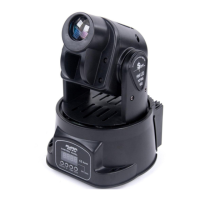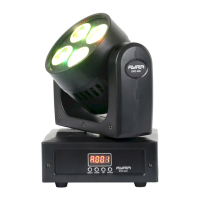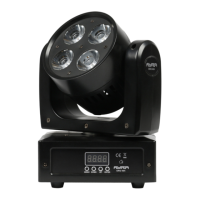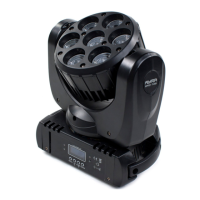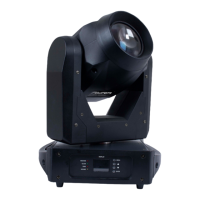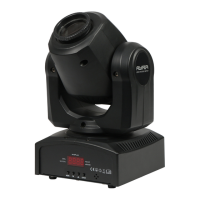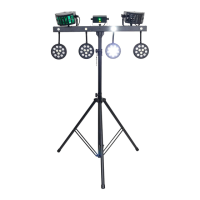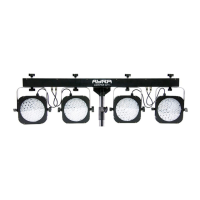Do you have a question about the Ayra ERO 075 and is the answer not in the manual?
Lists all items included in the package with the moving head, ensuring completeness before use.
Advises users to check for damage during transit and contact the retailer if any issues are found.
Provides essential warnings regarding electric shocks, proper connection, and handling of the device.
Outlines the necessary qualifications and responsibilities for anyone handling the device.
Lists crucial safety points such as avoiding liquids, heat sources, and proper disconnection.
Details best practices for transporting and storing the device to prevent damage and ensure safety.
Provides instructions for inspecting the device's housing, checking for damage, corrosion, and securing connectors.
Explains the WEEE directive for proper disposal and recycling of electronic equipment.
Indicates that the product meets European norms and requirements.
Specifies that the product is designed for indoor use and provides a maximum temperature limit.
Identifies the main moving head unit and its light output through the lens.
Describes the rubber feet used for stable placement of the device.
Highlights the LED display and menu buttons for device operation and settings.
Identifies the 3-pin XLR connector for DMX signal input.
Identifies the 3-pin XLR connector for DMX signal output.
Points out the power input port and the integrated fuse holder.
Indicates the fan located in the body for cooling the device.
Explains the correct procedure for confirming operating modes to ensure saved execution.
Details how to set the DMX start address for device communication.
Outlines the various operating modes available and their customizable functions.
Explains how to adjust display settings like language, screen rotation, and brightness.
Describes how to activate and control fixed positions and functions for static lighting effects.
Details the 'STAT' mode for viewing device statistics like firmware, operating times, and error logs.
Explains the automatic mode where the device runs without external factors.
Describes the sound-controlled mode, where the device reacts to music beats.
Details how to set up devices in Slave mode to synchronize with a master device.
Explains the comprehensive DMX mode for ultimate control via an external lighting desk.
Details DMX channels for controlling pan/tilt position, fine position, and movement speed.
Details DMX channels for controlling dimmer, shutter, and strobe effects with various patterns.
Details the DMX channel for selecting and controlling the colour wheel effects, including rainbow.
Details DMX channels for selecting gobo wheels, their shake effects, and rotation.
Details the DMX channel for adjusting the focus of the light beam.
Details DMX channels for controlling the prism effect and selecting auto modes.
Details the DMX channel for resetting the device via DMX.
Provides instructions for placing the device in an upright position on a stable surface.
Details how to attach the supplied mounting bracket to the top of the device.
Emphasizes the importance of using a safety cable with adequate load capacity for suspended installations.
Describes the powerful LED light source and advises against looking directly into the lens.
Explains the cooling system and the importance of keeping fans and vents clear.
States that the product cannot be repaired by the user and requires specialist maintenance.
Provides guidelines for regular cleaning and basic maintenance of the device.
Explains the purpose and use of a DMX terminator to prevent data reflections in DMX circuits.
Lists possible causes like a blown fuse or unplugged cable and their solutions for power-on problems.
Addresses issues with DMX signal reception, including incorrect start address or controller settings.
Troubleshoots problems with sound-activated modes, such as microphone sensitivity or speaker distance.
Offers solutions for reduced light output, like cleaning optics or checking dimmer settings.
Covers DMX signal issues like damaged cables, power interference, or missing terminators.
Explains how to resolve issues with changing operating modes, especially in Slave mode.
Provides solutions for shaky movements, possibly related to programmed speed or pan/tilt settings.
Addresses limited pan/tilt range and corrects movements that are operating in reverse.
Lists detailed technical specifications of the moving head, including light source, DMX channels, and dimensions.
Outlines various menu functions available for customizing device behavior and settings.
| light source power | 75W |
|---|---|
| beam angle | 11 degrees |
| colour wheel | 8 colours + open + rainbow effect |
| maximum power consumption | 105 watts |
|---|---|
| power supply | 110-240V AC, 50 / 60 Hz |
| power factor | 0, 6 |
| environmental temperature range | 0 - 40 degrees Celsius |
|---|---|
| housing temperature during normal use | 38 degrees Celsius |
| dmx operation channels | 14 channels |
|---|---|
| 3-pin xlr input and output for dmx | Yes |
| iec c14 power input | Yes |
| dimensions | 217 x 340 x 148 mm |
|---|---|
| weight | 4, 65 kg |
